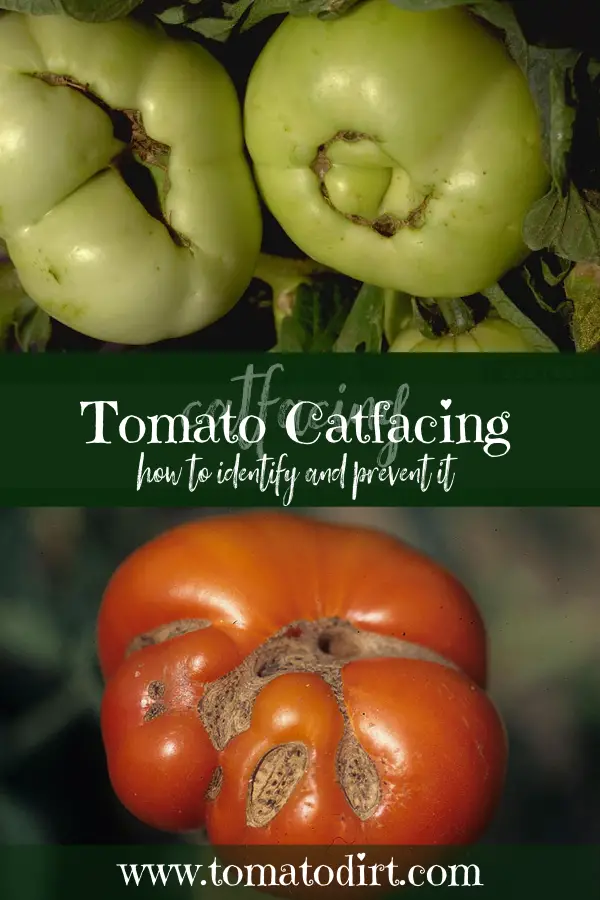FREE: 10 Must-Know Tomato Growing Tips Get The Guide
Read our affiliate disclosure here.
Tomato Catfacing: How to Identify and Prevent It
Since 2010, Tomato Dirt has garnered 4.8+ million views, making it the web’s leading online source for growing tomatoes in the home garden. Award-winning writer and Tomato Dirt owner Kathy Widenhouse has helped thousands of home gardeners grow healthier tomatoes. Be one of them when you get Tomato Dirt’s Growing Guide here.
Tomato catfacing is a disorder that affects fruit. It’s a disappointing condition but not fatal.
Here’s what happens. You’re all set to pick your ripening tomatoes until you take a peek on the undersides of the fruit. There you find unusual dimpling, indents, or puckering and some dark scars, which can run vertically up and down the tomato or in concentric circles
“Ugly fruit,” you may call it. The good news is that your tomato is not the victim of disease or pests. Instead, the fruit is simply misshapen, maybe with a few unattractive marks thrown in.
What is catfacing in tomatoes?
Tomato catfacing is a physiological disorder in tomato fruit caused by adverse growing conditions. Those conditions trigger abnormal development in a tomato plant’s blossoms.
Normally, tomato blossoms gather around a cylindrical stamen during pollination. But sometimes, two or more blossoms fuse together.
The result is misshapen malformations on the bottom of the tomato. The tomato forms multiple lobes, or folds in on itself as it grows or develops holes. Brown or gray scars may run up and down or across the bottom of the fruit.
What causes catfacing on tomatoes?
The gardening jury is out on this one – no one knows for 100% certain what causes tomato blossoms to fuse together resulting in catfacing. All explanations point to unfavorable growing conditions which lead to incomplete pollination – which in turn merges buds, creating deformities.
A number of factors contribute to growing conditions that influence poor or half-baked pollination.
- Cold weather. Low temperatures inhibit pollination, particularly when the thermometer is consistently below 58 F for successive days. That’s one reason why tomato catfacing is most common in the early part of the season and during a plant’s first wave of fruit.
- Nitrogen. If your soil has too much nitrogen -- or if you add too much nitrogen fertilizer to your plot -- then flowers bud quicker than usual and often incompletely.
- Thrips. They’re a type of bug that likes juice – tomato juice from blossoms, leaves and fruit. While thrips are at work damaging your tomato flowers and interrupting pollination, they also spread tomato spotted wilt virus. Keep your eye out for these nasties. They’re thin and have fringed wings.
- Heavy pruning. When you get scissor-happy with foliage, then there are fewer leaves and stems, which means less available growth hormones called auxins. Reduced growth hormones means decreased cell division, which can cause problems when blossoms convert to fruit.
- Herbicides: speaking of auxins, one possible cause of catfacing is exposure to herbicides that contain phenoxy. That’s a hormone that produces similar responses in tomatoes as auxins. Among the most common culprits are 2,4-D herbicides.
Can you eat a tomato with catfacing?
Yes, tomatoes with catfacing are edible. Cut away the scars. If the tomato has an open wound, check it carefully – lesions are known to attract bacteria, black mold, and other microorganisms.
How did tomato catfacing get its name?
The puckered shapes on the fruit look like the puckered cheeks on a cat.
Are some varieties more susceptible than others to tomato catfacing?
Some gardeners claim that heirloom tomatoes are more vulnerable to the disorder. Most certainly, large, round or globe tomatoes are more susceptible to tomato catfacing than plum or cherry varieties.
How to prevent catfacing on tomatoes
- Avoid setting out transplants too early in the season. This way, they won’t be subject to consistently low temperatures that lead to tomato catfacing.
- Grow smaller tomato varieties (such as cherry tomatoes and grape tomatoes). Catfacing affects large fruits more than smaller fruits.
- Pinch off catfaced tomato flowers. You’ll recognize them as two or more interior blossoms fused together.
- Avoid using herbicides. Find natural ways to eradicate weeds.
- Use a balanced tomato fertilizer. Apply a high nitrogen fertilizer only if a soil test reveals that your soil is nitrogen-deficient. Excess nitrogen encourages quick blossoming, which can encourage tomato catfacing.
- Avoid excessive pruning, especially when tomatoes are blossoming.
Are tomato catfacing and tomato zippering the same disorder?
Catfacing is similar to zippering. Both are caused by pollination problems and temperature changes, but the two are distinct disorders.
More Tomato Problems
Blossom end rot: how to identify, treat, and prevent it ...
Blossom drop – when tomatoes don’t set fruit ...
Why a tomato cracks and what to do about it ...
Help Your Tomatoes Set Fruit with These Tips ...
Sunscald: why too much sun can be hazardous to tomatoes ...
Are bumps on tomato stems harmful to plants?
15 ways to prevent blossom end rot in tomatoes ...
How to identify tomato problems and prevent them ...
More tips for managing tomato problems on our Pinterest board ...
Return from Tomato Catfacing to Tomato Dirt home
As an Amazon Associate and Rakuten Advertising affiliate I earn from qualifying purchases.
SHARE THIS PAGE:
FREE! 10 Must-Know Tomato Growing Tips: 20-page guide
Get yours here:




